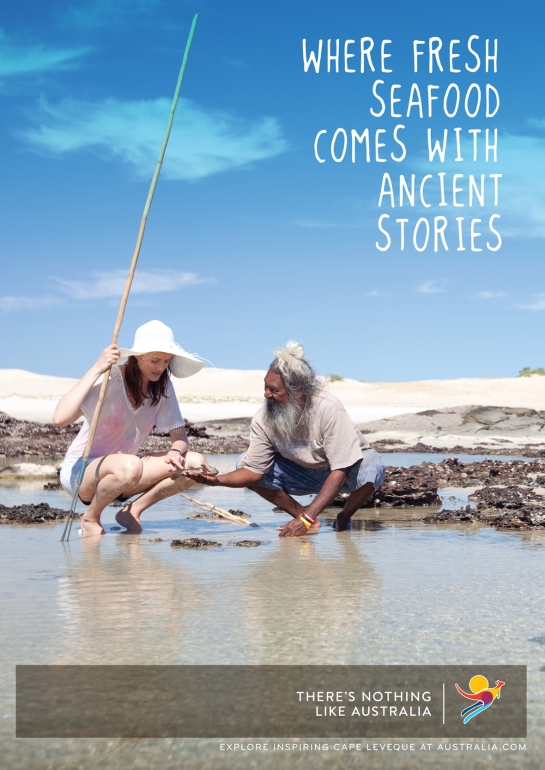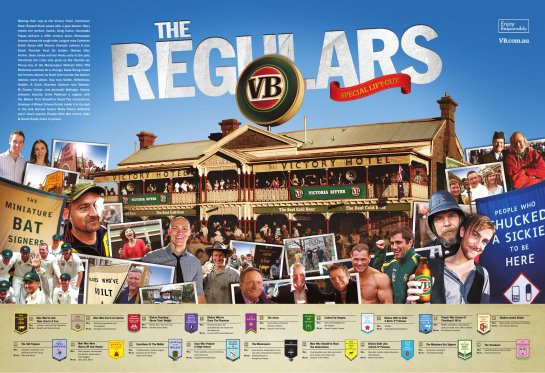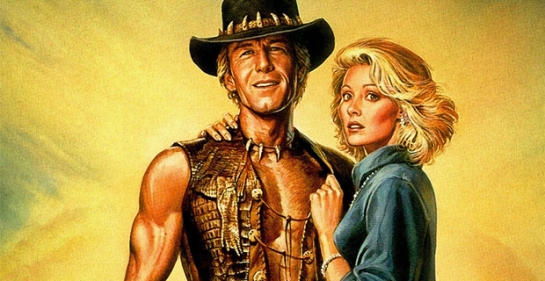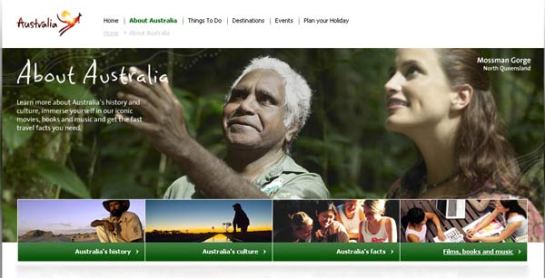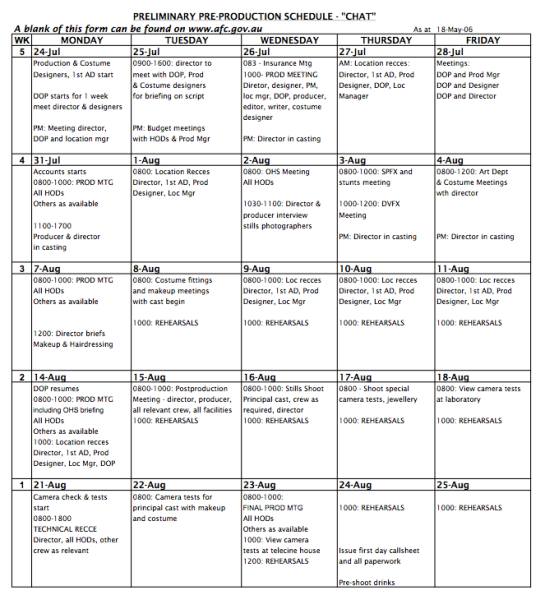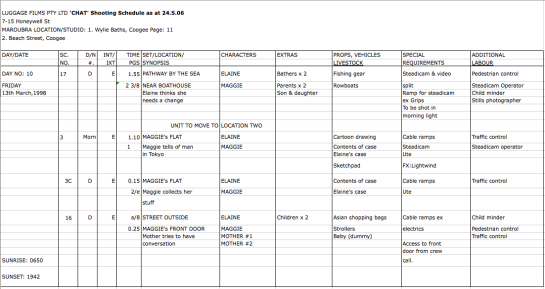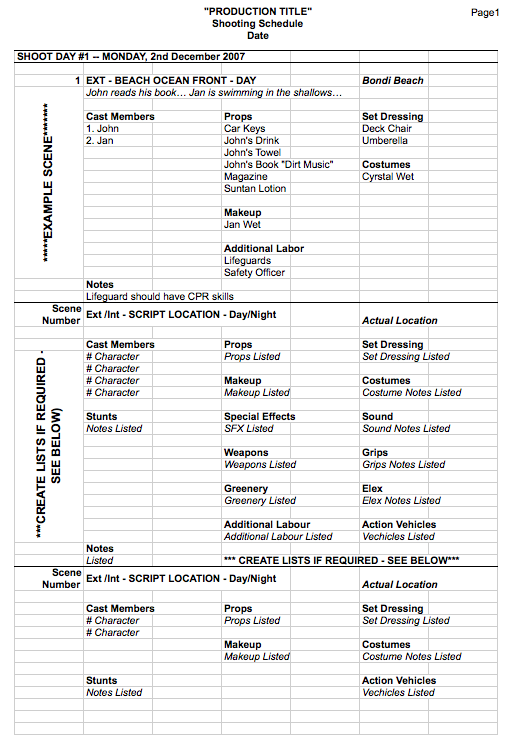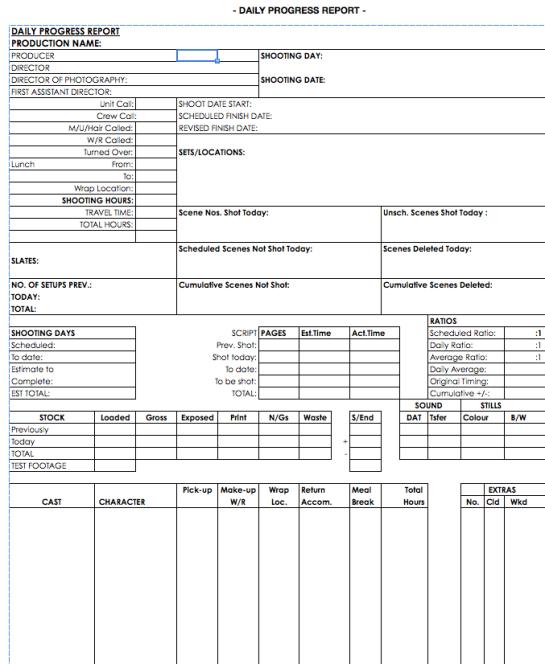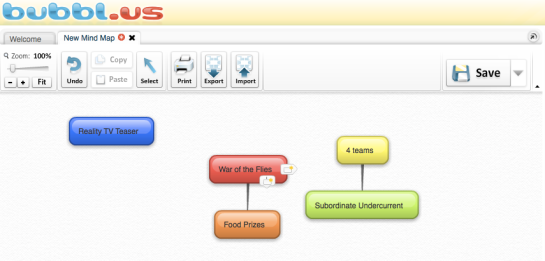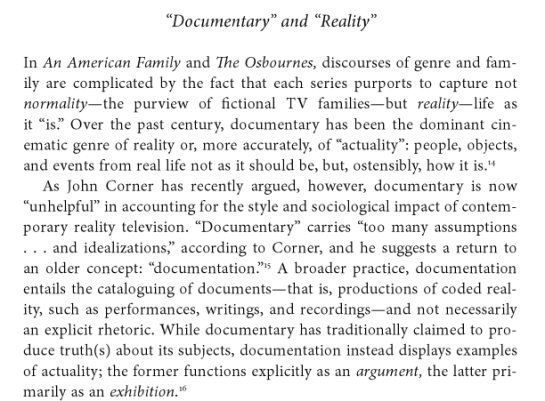- Australian values and attitudes
- Construction of a cultural group
- Point of View
- Preferred meanings
- Audience Impact
- Representation
- Commercial nature of Media
- Social Issues
- Selection Process
- Stereotypes
- Impact of technology on the Media
- Marketing Strategies
- Narrative codes & conventions
- Production Constraints
- Media Budgets
- Subcultures
Visual Stimulus
Video Production Sheets
WHY DO A PRODUCTION SCHEDULE?
In TV / film production it’s generally easier to start planning your production schedule at the end and work back. So think about when you need to deliver your film or project, put that date in the production schedule (calendar) first and work back considering adequate time for sound dubbing, editing, edit prep (script, music etc), logging rushes, digitizing rushes, filming, scripting and so on. This is your basic production schedule that you can do as many drafts as you like to get it workable within your constraints.
It should be a flexible document that you tweak and amend as things change on production (as they ALWAYS do). It is also an incredibly good record on how your production ran so that when you come to doing it again you have a reference and template. In more practical terms while you are in production, it is a live and up to date plan of where you are should you need to hand it over to someone else through illness or such like.
Setting up a production schedule is often done in excel (or however you like) and set up like a calendar so that you can plan all the elements from meetings, recce’s, filming, editing, finishing and delivery dates (of the film and the paperwork). It should be comprehensive so that anyone looking at it knows what you are doing when. This is a vital part of planning so you know you have thought of and planned everything. It often changes as you get into production and should be treated as a fluid piece of paperwork.
click->example-production-schedule<-click
Example—click->Callsheet<-click
Creating Reality TV Concepts
The Television Writers Vault is the television industry’s first and only website to bring new TV Show Ideas to global broadcast from Writers & Creators outside of the Hollywood system. In this article we share insight on creating and writing pitches for reality TV.
http://www.tvwritersvault.com/realitytv/creatingreality.asp
When marketing an original reality-based project to the television industry, be sure to explore the following points before you create and pitch your concept:
The Reality of Reality | What They Really Are…
If you look at most of the reality show ideas that get produced, they most often revolve around a specific issue or event that everybody can relate to, and out of that is built a game. They are in essence, game shows. But even more importantly, they are big fun, and often dramatic social experiments. Another thing to remember is that some things are fun to play, and some things are fun to watch. To truly connect with an audience and have entertainment value in a show, you need both. The quality of a reality-based show can span from awful to inspiring. But the reason viewers tune in is because we have an insatiable appetite for witnessing and being entertained by the human experience.
Conceiving and Creating:
Be Specific in your concept, and try several approaches- Here’s a typical scenario that will give you an idea of why being specific and unique is important: “Ms. Network Executive” gives a production company executive the inside scoop that they would love to find a show that places contestants in some sort of “fish-out-of-water scenario” and would like it to involve a family. That in itself is a generic idea, but it does send the creative mind in a specific direction. What she’s hoping is that you will be the one to deliver an approach to that concept that is totally unique and something they never would have thought of. They may be spending time trying to develop the concept internally, while also taking pitches from a handful of producers. Many producers will create two or three variations on the same concept. And each of those will give you a different result, a different experience as a viewer, and therefore they are considered by any executive taking stock- different shows. So don’t be afraid to work on several shows within the same theme. It can only increase your chance of making a sale.
Choose concepts and subjects that are highly marketable- Titles are very important, they should roll off the tongue easily, provoke conversations, and simply tell you exactly what you’re going to be watching. “The Bachelor”, “The Apprentice”, “Gold Rush”, “Wife Swap”, “The Biggest Loser”, “America’s Got Talent”, “LA Ink”, “Flipping Out”, “Blind Date”, “Little People, Big World”, “Queer Eye For The Straight Guy”, “Pawn Stars” are all good examples. Word play is always a good way to grab attention and create curiosity. “Meet the Parents”, “Wife Swap”, and “Blind Date” are all specific to what their show is about, but use known phrases to create new titles that peak curiosity.
Think of movies– “Story” is a critical element to define when developing a reality-based project. When you look at movies, look at the core concept and story elements of the film, and a reality show just might be staring you smack in the face. “Cannonball Run”, “Meet the Parents”, “Around the World in Eighty Dates” “The Fugitive” are all specific examples of film concepts that have translated into reality-based shows for television.
Identify Unique Professions or Lifestyles: One of the simplest and most successful sub-genre of reality show is the documentary style series covering unique professions or lifestyles. These stories serve the insatiable curiosity viewers have to gain insight into other peoples lives and jobs. Bravo’s “The Real Housewives of Orange County” is a guilty-pleasure glimpse into the spoiled and faux-glamorous lives of a certain group of women in Orange County, California. Discovery Channel’s “Deadliest Catch” takes us out on the high seas with Alaskan king crab fishermen battling giant waves and wind as they fight to pull their catch and earn a days pay. Both of these series are covered in documentary style format, so if you have a subject or idea for a reality series that fits into this style, you’ve got to have the actual people involved to pitch it. Repo men may have a compelling profession, but you’ll need to have the stories of the actual, specific repo man that would star in the series. Again, it’s not just pitching the idea, but pitching the specific person and profession that the series would be focused on. For help in this area, feel free to contact Scott Manville at the TV Writers Vault for some expert advice, and read more about pitching docu-style reality series’ Here.
They are plays in morality or social experiments. “Survivor”, produced by Mark Burnett Productions, is a microcosm of our society. We are stuck living together, therefore we must get along. Each person must strategize to win, but must do so without creating enemies, because it is their neighbor that votes if they can continue or if they get kicked out. It isn’t always fair, and therein lies the fun. In that pressure-cooker atmosphere we see the players true character rise to the surface. Even though the show is set up, you get real drama. Another example: To put a group of young adults together in the same house that are strangers, living, working and playing creates an inherent “soap opera” for the audience to watch. That was Bunim/Murray Productions’ “The Real World”, and it opened up the young viewing audience to a new form of compelling TV. Documentary-style coverage of a set-up situation.
“The Apprentice”, another Mark Burnett brainchild, has similar game elements to that of Survivor but takes place in a different jungle- the corporate jungle. Aspiring business mavens must work together under the scrutinizing eye of Donald Trump. Poor performers of the weekly business task face Trump in his boardroom where each week one person is fired. A marketing person will tell you that people will tune into this show to see Trump fire someone each week. True! But the reason viewers find it compelling to watch is because of the specific moments of drama that come out of situations and challenges that face us all. As in most dramatized pieces, it is a “heightened reality” that makes it entertaining to watch.
A show that branded the cable network of Bravo with a “Network Hit”, “Queer Eye for the Straight Guy” was a simple and entertaining formula that brought opposite worlds together when hapless straight guys are thrown to the mercy of five gay experts in all that is hip and chic, in hopes of resurrecting their lifestyle and appearance. The result of bringing these two mismatches together…. comedy and quality entertainment. The lynch pin in this show isn’t the obvious “comedy that ensues”, but the heart strings that the show touches when someone’s life is changed for the better. You’ll notice this as the root of any successful makeover show. It’s not about the makeup and furniture, it’s about changing lives.
Another show that received great critical acclaim in reality programming is “Wife Swap” on ABC. Beyond being a “fish-out-of-water” concept, the show is built on casting “oil and water”. Husbands and wives discover the grass ISN’T always greener when they swap husbands or wives to experience family life through someone else’s perspective and practices.
One example of a good concept that didn’t find life as a franchise was the WB reality series, “High School Reunion”. A production executive went to their high school reunion and experienced the organic drama and issues that are alive at any high-school reunion. That was the nucleus of what became a prime-time reality show. The show keys on the characters we all know; the beauty queen, the jock, the nerd, the bully, the loner, the gossipers, the rockers, etc. They chose to build the show around a ten-year reunion because having most of the people at age 28, they’ll find a large chasm in the career and life progress of each person. Some will already be huge successes, some will have taken turns for the worse, most will be insecure and frustrated. Again, it is all built for drama. And you can be sure that there will be humor with revenge fantasies played out, unrequited love rekindled, or even a grudge match between the ex-nerd turned judo champ and the ex-bully turned couch potato. It’s something we all relate to, and fun to watch.
ABC’s hit franchise “The Bachelor” is both simple in concept and execution, but what the Producers of the show know how to do is pull drama from specific moments of tension and anticipation. It’s classy, it’s romantic, and again- it’s real drama that we’re watching. And one thing that puts it a cut above the rest is that it isn’t necessarily a journey of breaking hearts as much as it is a journey of two people finding true love with each other (that hopefully lasts beyond the air-date of the show). The show romanticizes the courting process and we can’t get enough of it.
Another form of reality-based programming that came back into play has been the hidden-camera show. A few of the more popular shows have been “The Jamie Kennedy Experiment” and “Punked”. The segments are semi-scripted for direction, but improvised by the actors involved with the “marks” that the joke is being played out on. The concept is simple but limitless- You have very talented improv actors posing as a variety of characters in varying situations that are all fabricated, and always funny. Unsuspecting “marks” become players in what is essentially an unscripted scene of comedy and drama.
Treatment Structure
Sample Pitch & Treatment Format
When registering to pitch a project to industry executives at the TV/Film Rights Marketplace, you’re required to submit an original Title, Logline and Synopsis of the project, in addition to other elements of the project’s profile (subjects and themes) that may apply, which together creates a “Treatment”. Below are some basic definitions with a bit of guidance for each. This should provide some specific insight for understanding how a pitch should be communicated for each main genre. There are no set rules, but there are some essential practices that help bring your pitch to life on the page.
What’s A Treatment?
[def.- A detailed pitch or summary of a story, format, or concept for the purposes of selling to entertainment industry executives. Length and content varies by genre, but will always include a Logline and Synopsis.]
Title
A great title is the first thing to draw in a Producer, and ultimately the viewers. It should be clever and clear. Clever, in the way the Title is unique, ironic, compelling or funny. Clear, in the way it tells what it is we’re going to see. Stay away from creative titles that are so off-the-mark there’s no clue or even indirect suggestion as to what the movie or tv show is about. Simple is great. Simple and creative is even better.
Logline
What’s a Logline? A one or two sentence short pitch that gives the main objective of a story or concept, as well as any unique hook or twist. It does take talent to boil down your overall concept into a one-two punch for a great logline, so practice writing several until you hit on the right message that will hook a potential buyer’s interest in the project. Here’s a few approaches…
Logline for TV Reality Series Concept
In a reality series logline you want to make impact by illustrating the extremely unique or compelling circumstances, set-up, or content for the show. Be very straight forward, and give the big hook or payoff that it leads to. If pitching a docu-series based on people or a profession, detail the subject and unique circumstances that would indicate it’d be entertaining to watch.
Synopsis
Synopsis for TV Reality Series Concept
This may be 1 to 3 pages. The key to good reality format writing is to be able to describe what we’re potentially watching. Some new writers get too caught up in the high concept or “idea” of the show, when the real challenge is in specifying what we’re actually watching in the series. Set the circumstances for the series describing how it progresses, who is involved, and specific examples of outcome. Also keep in mind that there should be a specific goal, or ultimatum involved. Although reality TV is unscripted, you need to create scenarios and circumstances that create potential for drama, humor, or other entertaining content.
SAMPLES
Title:“Broadway Bound!”
Logline (short pitch):”Waiting For Guffman” meets “American Idol”. A flamboyant Broadway director and choreographer descend on a small town, infiltrating the local play. One performer will be taken back to Broadway for a featured part in a real Broadway show.
Synopsis: [content should be 3 to 7 paragraphs outlining the content of the show as it unfolds. Be specific and original in your execution]
A Docu-Style Reality Series for Television.
In every small town, there are big dreams…
In Washbuckle, Missouri the regional theatre holds open casting calls for their annual musical review. Some members of the troupe have dreams of making it to Broadway or Hollywood. Others are content in being the star of Washbuckle, Missouri hogging what little limelight there is year after year.
But what happens when, just one week before opening night, a ruthless Broadway Director and Choreographer drops into town with the agenda of taking control of the small town production while scouting for talent to find his “star”? It’s a fascinating look at big dreams in small town America. The personal stories and archetypical characters that collide as opening night approaches. The ego-maniacal local theatre director getting systematically pushed aside by the big-city Broadway director. The humorous moments as the city-slickers struggle to tolerate the small town ways and mentality. The infighting among potential cast members. The panic that ensues as the cast, choreography, and production are turned on it’s tail at the eleventh hour. The inspiring moments that rise to the surface amidst the chaos of opening night…. And “the decision”. One person from the cast will be chosen for a spot in a hit Broadway production, a trip to Hollywood for a spot on a soap-opera and every chance they could ever hope for being famous?
Seven episodes:
1. Meet the town folk. Get to know the key characters and the theatre group. We’ll also watch in parallel the merciless Broadway Director in action in New York, seeing the contrasts in both characters. We’ll take a humorous look at the awful auditions for the small town play. We’ll see the announcement (or rumor) of the impending arrival of the Broadway Director scouting for talent, and witness the anxiety that is infused in each of our small town characters fighting to get into the play.
2. In-fighting, tensions escalating, accusations, the director starts feeling the pressure. People are cast. Hearts are broken, hopes are sparked. They have a first run-through with the cast. The mysterious Broadway director in black sits in the back. (Imagine a Simon Cowell) snapping from the back row, “Stop! Every one of you STOP!!” He then marches down the isle. An imposing figure. He introduces himself and delivers the news that he has come to find talent. And someone from this town, in this play, will be chosen. He goes on about how he sees nothing but problems. The play will be re-cast, the production will stop now! (One week before opening night)
3. The new director and small-town director fight. Cast members protest. New auditions are held, and performances scrutinized. A new cast is announced, and from that cast will come his “star”.
4. The pressure is on to bring it together for opening night, we’ll cover four days of rehearsals, as well as the personal struggles surrounding the production. Anticipation, anxiety, resentment, hope, adrenaline. Opening night! We see the performance and the reactions of our Broadway director. Cliff-hanger for his decision on who will be Broadway bound!
5. Re-cap of the series, the performances, the arguments, and finally… the decision. One of the people that landed a role, large or small in this little play is chosen. We share in the afterglow, the elation, and the disappointment of others. And sharing a dream come true for that one person selected.
6. Broadway New York!! Our winner is whisked around like a star. Taken backstage of a REAL Broadway production, immersed in the whole lifestyle. Meetings with Hollywood talent scouts, directors of other productions, agents, etc.
7. We see our small town hero take his leap of faith, jumping headfirst into a Broadway show. A dream is realized.
END
Title:”The Last Tango”
Logline: Five soon-to-be engaged couples will face their fidelity as their relationships are tested, ultimately proving their readiness or rejection of the biggest commitment of their lives. Temptation Island” meets “Around the World in Eighty Dates”
Synopsis: Five soon-to-be-engaged couples will be brought together for a relationship-altering journey. In this series, each person will explore and discover what their relationship is really made of when faced with The “Last Tango”. Those couples cast will be currently involved in a “long engagement” or living together as boyfriend/girlfriend for an extended period. All will be at a turning point, or breaking point in their relationships.
Each couple will be separated into groups of five men and five women. We will then follow each group of men and women on a romp-around-America Last Tango before marriage. Locales will be Hawaii, Las Vegas, Nashville, New York City, Beverly Hills, and Miami. On their journey they will be set-up at events, outings, and other social adventures where they will meet and spend time with a variety of tempting prospects or “dates”.
Each of our couples will be privy to fear-provoking information about their significant other’s activities while they themselves are in the midst of their own journey of temptation, or perhaps the discovery of a new love. It’s a triangle of conflict that will boil over into the final episode when our couples are reunited.
====
====
[SAMPLE EPISODE SEGMENTS SHOULD BE DETAILED IN THIS PORTION]
====
====
Final Episode: One person of each couple does not know they will return from their Sabbatical to face an ultimatum by their partner on Live TV. It is at that moment they will be confronted by their significant other who poses the ultimatum; “Marry me now, or lose me forever”.
Each relationship faces peril or a prize; to part separate ways or get married at that moment. Ten adventures, five couples, five ultimatums, all leading to five moments of drama on Live TV.
For some it will be the final straw. For others, a new beginning.
“Can your relationship survive The Last Tango?”
Bubbl.us
Representation… in minutes
- What do we have to remember when we are thinking about representation in media?
- Representations are created through a process of 3 things?
- Photographs are ?
- The decisions that are made in the construction of a representation all affect the??
- Write the definition for a code.
- List 3 examples of codes.
- What’s the difference between denotative and connotative?
- What’s a good example of a code?
- List 4 examples of media production codes.
- What is important to think about in the study of media representation?
- Why is it important to understand the deconstruction of media?
My Kitchen Rules Wins
My Kitchen Rules wins 1.67m for Seven as Nine’s The Block averages 1.14m
![]()
![]() In the first major television night of the year Seven won 1.671m viewers for the first episode of My Kitchen Rules as Nine’s first outing of The Block averaged 1.143m according to OzTam.
In the first major television night of the year Seven won 1.671m viewers for the first episode of My Kitchen Rules as Nine’s first outing of The Block averaged 1.143m according to OzTam.
The fifth series launched with a new cast of home cooks who are judged on meals they cook for their competitors, and judges Manu Feildel and Pete Evans, opened to 1.384m on January 29 last year.
Meanwhile The Block, now in its ninth season, brought back previous contestants for a Fans v Faves series, fell to seventh for the night as it premiered in the later 7.30pm timeslot against My Kitchen Rules.
The stiff competition from the two shows drove down Ten’s audience for The Biggest Loser as it had 560,000 metro viewers last night, after opening to 753,000 last Sunday.
My Kitchen Rules was also the the top program in people 25-54, with The Block second, while The Biggest Loser was 10th in that demo, Ten’s stated target demographic.
Although the official ratings season does not open for another two weeks the network’s launched their premium products yesterday, as Seven launched its shows after the tennis.
Seven’s first episode of Home and Away for the year had 1.221m viewers, again taking the lead over Nine as A Current Affair in the 7pm timeslot.
Nine’s top performer was its own news program as 1.33m metro viewers watched the first half hour and 1.19m stayed tuned for the second, preliminary overnight ratings show.
In the breakfast battle Seven’s Sunrise won in all cities on Monday with a total of 338,000 viewers across the five cities as Today dropped to 200,000.
Today lost its EP Neil Breen last year, as well as producer Steve Wood who moved from Today to Channel Ten’s Wake Up last week after 12 years with Channel Nine’s Today.
Wood replaces Wake Up executive producer and creator Adam Boland who announced his departure last week. The show averaged 22,000 metro viewers yesterday, one of its lowest ratings since its debut of 52,000 in November.
In the competition between Nine and Seven’s evening gameshows Nine’s Hot Seat was stronger with 752,000 total viewers as Seven’s first episode of Million Dollar Minute since Grant Denyer’s departure averaged 492,000. Simon Reeve replaces Denyer as host of the show launched in September.
Over the weekend The Australian Open Men’s Final brought an average 1.661m viewers to Channel Seven on Sunday, and the women’s final had 1.148m on Saturday.
The one day cricket match between England and Australia averaged 654,000 for the first session and 1.068m for the second on Friday, with the nail-biting second session on Sunday, up against the Men’s final, getting 942,000 in the capital cities.
Seven had the largest audience share last night with 26.3 per cent however Nine’s audience share was only slightly smaller with an estimated 24.3 per cent. Ten just slipped to fourth for the night as it’s audience share was 11.4 per cent and ABC1 had a 11.6 per cent share of the audience.
Monday’s top 15 shows:
- My Kitchen Rules Seven 1.671m
- Nine News Nine 1.33m
- Seven News Seven 1.255m
- Seven News/Today Tonight 1.251m
- Home and Away Seven 1.221m
- Nine News 6.30 Nine 1.19m
- The Block: Fans v Faves Nine 1.143m
- A Current Affair Nine 1.008m
- ABC News ABC1 886,000
- The Blind Side Nine 843,000
- Hot Seat Nine 752,000
- Ten Eyewitness News Ten 706,000
- QI Rpt ABC1 691,000
- 7.30-EV ABC1 677,000
- ABC News Update ABC1 628,000
Monday’s share:
- Seven 26.3%
- Nine 24.3%
- ABC1 11.6%
- Ten 11.4%
- SBS ONE 4.4%
- GO! 3.2%
- 7TWO 3.0%
- ELEVEN 2.8%
- 7mate 2.7%
- ABC2 2.5%
- Gem 2.3%
- ONE 2.3%
- ABC News 24 1.2%
- ABC3 1.0%
- SBS 2 0.9%
- NITV 0.1%
Data copyright of OzTAM Pty Limited 2013. The Data may not be reproduced, published or communicated (electronically or in hard copy) in whole or in part, without the prior written consent of OzTAM.
http://mumbrella.com.au/kitchen-rules-wins-1-67m-seven-nines-block-averages-1-14m-202377
My Kitchen Rules had strongest engagement in battle of reality TV shows on Twitter
An analysis of how My Kitchen Rules, The Block: Fans v Faves and The Biggest Loser performed on Twitter has pinpointed the areas of interest for viewers in a graph that shows the shows’ performance in the OzTam ratings has been reflected in social media.
While My Kitchen Rules won over the largest audience, with some 1.6m viewers for the first episode on Seven in the 7.30pm timeslot on Monday, research by QUT’s Centre for Creative Industries and Innovation shows My Kitchen Rules (MKR) was not only the most-watched, but also the show most engaged with on social media.
“Our Twitter excitement index shows people are engaging with the content because something is provoking a large group of people to tweet at the same time,” said Darryl Woodford, a postdoctoral research fellow with the Centre.
“It gives the networks a raft of information and gives them the ability to see which particular moments of the show people connect with, and whether they were excited or annoyed by it.”
As the three shows ranked first, second and third in the timeslot on Monday, they also ranked in that order according to Twitter activity.
Data collected by Woodford and his colleague Kate Guy shows the first episode of MKR generated 67.8 per cent of activity from unique tweeters, compared with 26.5 per cent for Nine’s The Block and 5.7 per cent for The Biggest Loser on Ten.
Woodford said this correlates with the OzTam ratings as My Kitchen Rules appeared to hold 60 per cent of metro viewers while The Block had 27 per cent and The Biggest Loser had 13 per cent of the audience at 7.30pm.
He also found that around a quarter of the people who tweeted about The Biggest Loser during its premiere one week earlier had also tweeted about one of the other shows when they were launched on Monday night.
 In a further assessment of how popular reality shows premieres and finales performed on social media the Big Brother Australia finale of 2013 generated by far the most tweets:
In a further assessment of how popular reality shows premieres and finales performed on social media the Big Brother Australia finale of 2013 generated by far the most tweets:
 “In general the Big Brother nominations and eviction shows rank quite highly. They’re always going to drive more engagement because it’s event television,” Woodford said.
“In general the Big Brother nominations and eviction shows rank quite highly. They’re always going to drive more engagement because it’s event television,” Woodford said.
He and his team are now building their Australian data to branch into activity stirred by non-reality shows such as The Big Bang Theory. Through their research of the US market they found sitcoms that regularly rate highly are not producing activity on social media and Woodford is curious to find out if this will be the same in Australia.
“In the US Twitter is such a small proportion of the overall audience and we want to see is whether that holds true for Australia,” he said.
Further research will look at whether the airing of shows in different time zones will affect the Twitter conversation, as it has in the US, where there is less activity on Twitter if the show has aired earlier in another time zone.
Reality TV Learning Activity
Watch the following & answer the questions:
- What is the sub-genre of the program?
- Summarise the premise of the program (e.g. contestants are asked to create a meal under specific conditions).
- What impact does the budget have on the program’s style in terms of technology used and production personnel (e.g. small crew of presenter, camera operator and audio recorder enabling lower production costs and flexibility of location)
- What values and attitudes are being promoted or are reflected in the content of the program?
- What does this reflect about the intended ‘target’ audience and their context?
- How does the program cater for audience interaction (e.g. direct through voting or interest through specific website on the content)? What impact does this interaction have on the content?
Differences Between Documentary & Reality TV
Some people would consider the documentary is closer to the truth than reality TV.This idea is based on the fact that reality programmes usually “create situations thatwould not have existed so that observational programme makers can shoot them”(Bignell, 2005:68).

